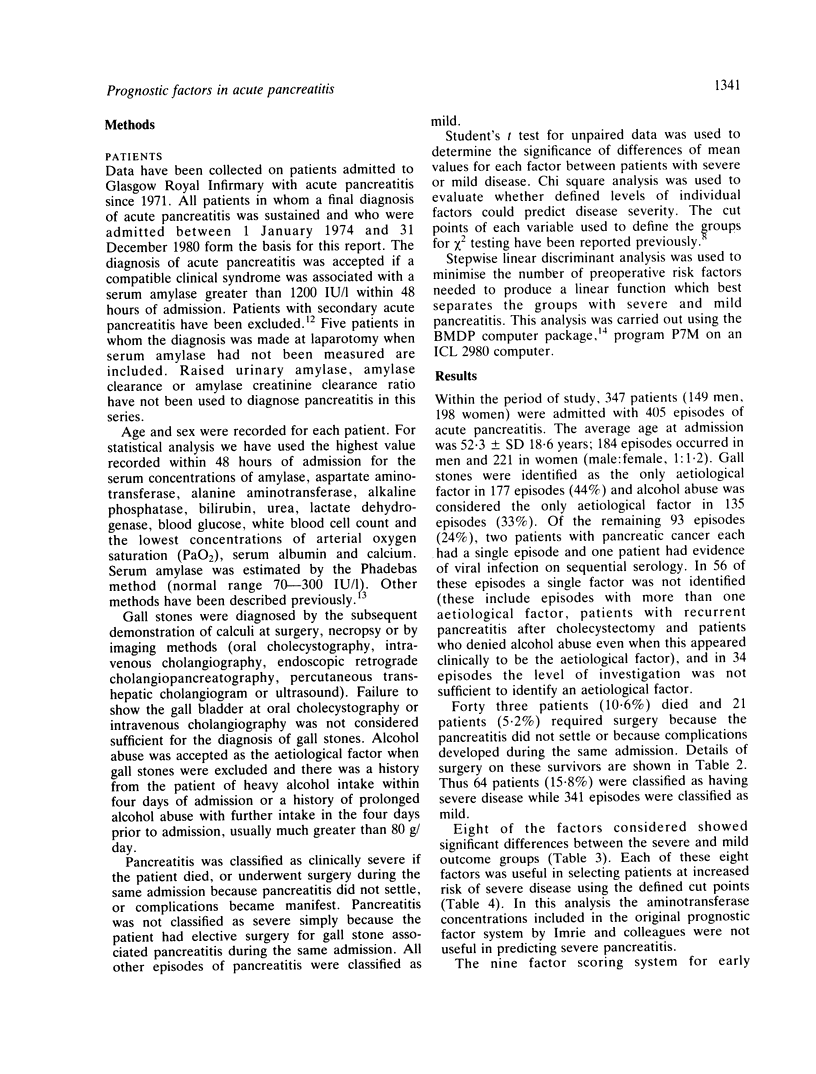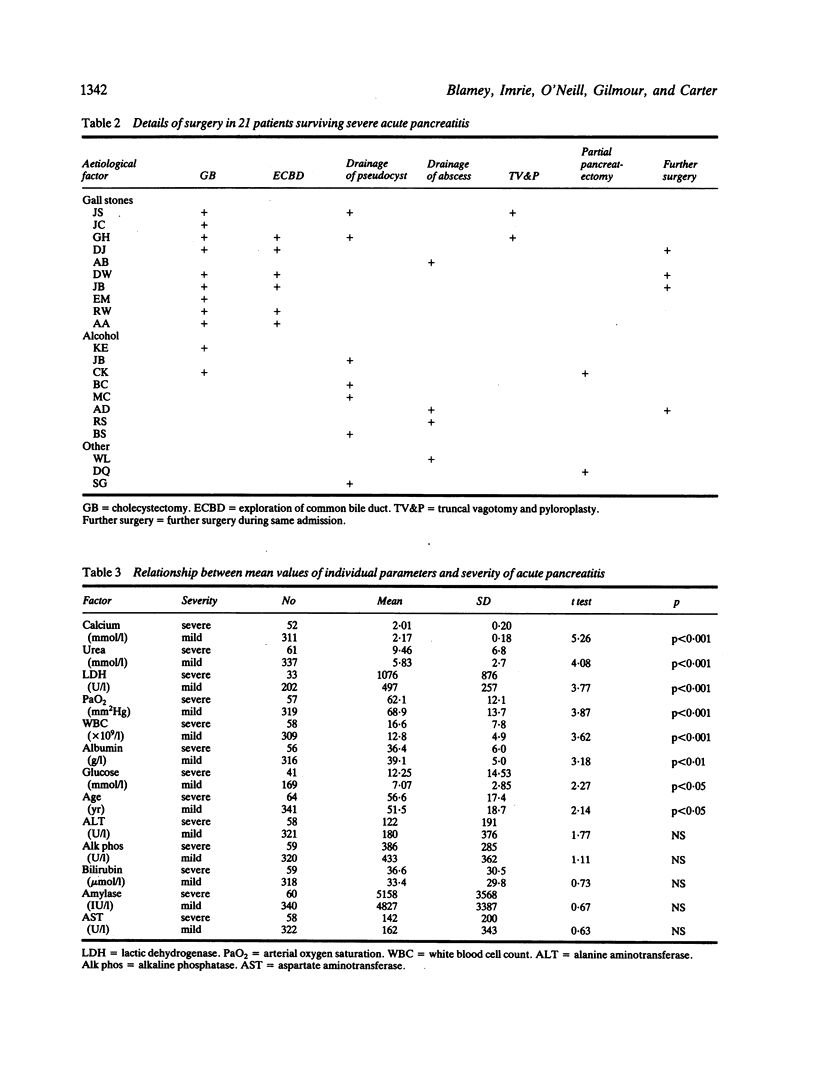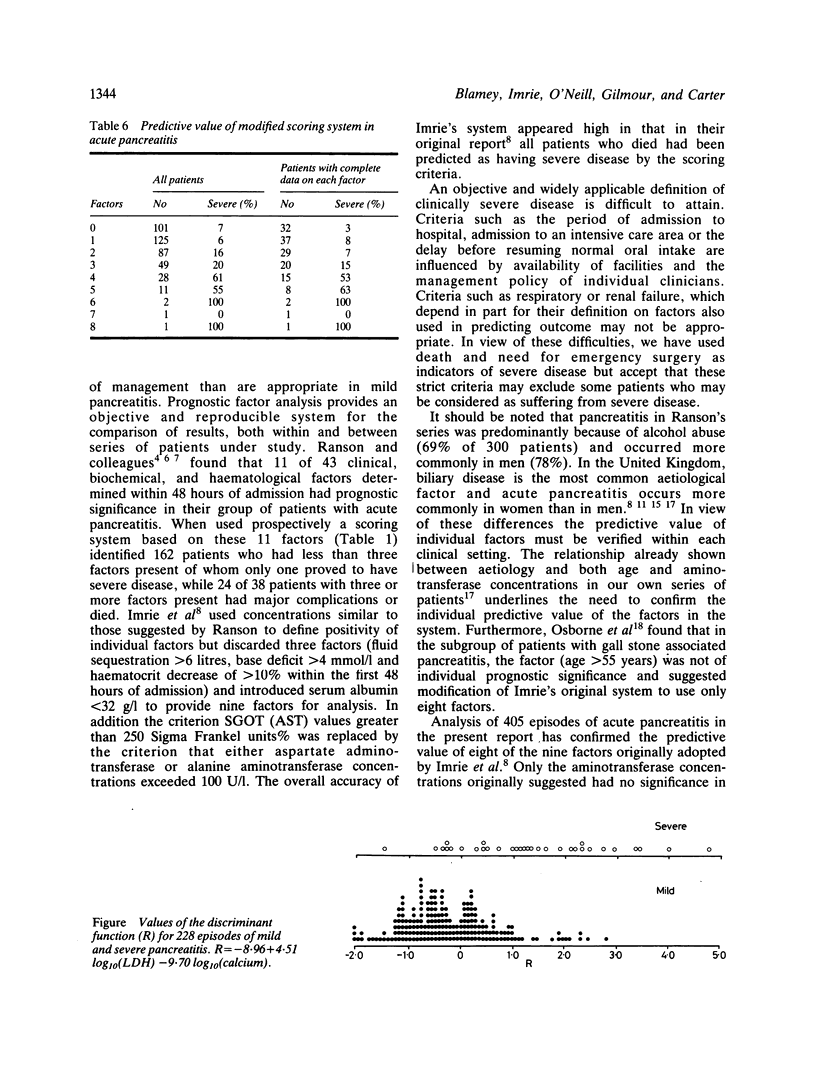Abstract
Prognostic factor scoring systems provide one method of predicting severity of acute pancreatitis. This paper reports the prospective assessment of a system using nine factors available within 48 hours of admission. This assessment does not include patient data used to compile the system. Of 405 episodes of acute pancreatitis occurring in a seven year period, 72% had severity correctly predicted by the system; 31% of 131 episodes with three or more factors present were severe and 8% of 274 episodes with less than three factors were severe. Assessment of individual factors revealed only one which did not predict severity. A scoring system based on the other eight factors correctly predicted severity in 79% of episodes. Prognostic factor scoring systems (i) alert the clinician to potentially severe disease, (ii) allow comparison of severity within and between patient series and (iii) will allow rational selection of patients for trials of new treatment.
Full text
PDF






Selected References
These references are in PubMed. This may not be the complete list of references from this article.
- Acosta J. M., Rossi R., Galli O. M., Pellegrini C. A., Skinner D. B. Early surgery for acute gallstone pancreatitis: evaluation of a systematic approach. Surgery. 1978 Apr;83(4):367–370. [PubMed] [Google Scholar]
- Berry A. R., Taylor T. V., Davies G. C. Diagnostic tests and prognostic indicators in acute pancreatitis. J R Coll Surg Edinb. 1982 Nov;27(6):345–352. [PubMed] [Google Scholar]
- Blamey S. L., Osborne D. H., Gilmour W. H., O'Neill J., Carter D. C., Imrie C. W. The early identification of patients with gallstone associated pancreatitis using clinical and biochemical factors only. Ann Surg. 1983 Nov;198(5):574–578. doi: 10.1097/00000658-198311000-00002. [DOI] [PMC free article] [PubMed] [Google Scholar]
- Glazer G., Murphy F., Clayden G. S., Lawrence R. G., Craig O. Radionuclide biliary scanning in acute pancreatitis. Br J Surg. 1981 Nov;68(11):766–770. doi: 10.1002/bjs.1800681105. [DOI] [PMC free article] [PubMed] [Google Scholar]
- Imrie C. W., Allam B. F., Ferguson J. C. Hypocalcaemia of acute pancreatitis: the effect of hypoalbuminaemia. Curr Med Res Opin. 1976;4(2):101–116. doi: 10.1185/03007997609109289. [DOI] [PubMed] [Google Scholar]
- Imrie C. W., Benjamin I. S., Ferguson J. C., McKay A. J., Mackenzie I., O'Neill J., Blumgart L. H. A single-centre double-blind trial of Trasylol therapy in primary acute pancreatitis. Br J Surg. 1978 May;65(5):337–341. doi: 10.1002/bjs.1800650514. [DOI] [PubMed] [Google Scholar]
- Imrie C. W., McKay A. J., Benjamin I. S., Blumgart L. H. Secondary acute pancreatitis: aetiology, prevention, diagnosis and management. Br J Surg. 1978 Jun;65(6):399–402. doi: 10.1002/bjs.1800650609. [DOI] [PubMed] [Google Scholar]
- Kelly T. R. Gallstone pancreatitis: the timing of surgery. Surgery. 1980 Sep;88(3):345–350. [PubMed] [Google Scholar]
- McMahon M. J., Playforth M. J., Pickford I. R. A compaative study of methods for the prediction of severity of attacks of acute pancreatitis. Br J Surg. 1980 Jan;67(1):22–25. doi: 10.1002/bjs.1800670107. [DOI] [PubMed] [Google Scholar]
- Osborne D. H., Imrie C. W., Carter D. C. Biliary surgery in the same admission for gallstone-associated acute pancreatitis. Br J Surg. 1981 Nov;68(11):758–761. doi: 10.1002/bjs.1800681103. [DOI] [PubMed] [Google Scholar]
- Ranson J. H., Pasternack B. S. Statistical methods for quantifying the severity of clinical acute pancreatitis. J Surg Res. 1977 Feb;22(2):79–91. doi: 10.1016/0022-4804(77)90045-2. [DOI] [PubMed] [Google Scholar]
- Ranson J. H., Rifkind K. M., Roses D. F., Fink S. D., Eng K., Spencer F. C. Prognostic signs and the role of operative management in acute pancreatitis. Surg Gynecol Obstet. 1974 Jul;139(1):69–81. [PubMed] [Google Scholar]
- Ranson J. H., Rifkind K. M., Turner J. W. Prognostic signs and nonoperative peritoneal lavage in acute pancreatitis. Surg Gynecol Obstet. 1976 Aug;143(2):209–219. [PubMed] [Google Scholar]
- Ranson J. H., Spencer F. C. The role of peritoneal lavage in severe acute pancreatitis. Ann Surg. 1978 May;187(5):565–575. doi: 10.1097/00000658-197805000-00016. [DOI] [PMC free article] [PubMed] [Google Scholar]
- Ranson J. H. The timing of biliary surgery in acute pancreatitis. Ann Surg. 1979 May;189(5):654–663. doi: 10.1097/00000658-197905000-00016. [DOI] [PMC free article] [PubMed] [Google Scholar]
- Safrany L., Cotton P. B. A preliminary report: urgent duodenoscopic sphincterotomy for acute gallstone pancreatitis. Surgery. 1981 Apr;89(4):424–428. [PubMed] [Google Scholar]
- Stone H. H., Fabian T. C., Dunlop W. E. Gallstone pancreatitis: biliary tract pathology in relation to time of operation. Ann Surg. 1981 Sep;194(3):305–312. doi: 10.1097/00000658-198109000-00008. [DOI] [PMC free article] [PubMed] [Google Scholar]
- Stone H. H., Fabian T. C. Peritoneal dialysis in the treatment of acute alcoholic pancreatitis. Surg Gynecol Obstet. 1980 Jun;150(6):878–882. [PubMed] [Google Scholar]
- Trapnell J. E., Duncan E. H. Patterns of incidence in acute pancreatitis. Br Med J. 1975 Apr 26;2(5964):179–183. doi: 10.1136/bmj.2.5964.179. [DOI] [PMC free article] [PubMed] [Google Scholar]


